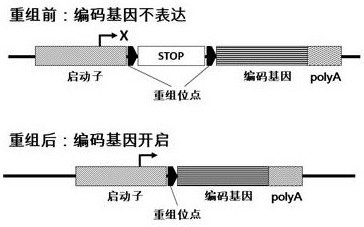Method for Regulating Gene Expression Using Recombinase
A recombinase, genome technology, applied in the field of genetic engineering
- Summary
- Abstract
- Description
- Claims
- Application Information
AI Technical Summary
Problems solved by technology
Method used
Image
Examples
Embodiment 1
[0064] It was verified that the recombinase recognition site containing the inverted repeat sequence capable of forming a stem-loop structure hinders the expression of downstream genes. Methods as below:
[0065] build as Figure 4 The plasmid vector pBSK-Neo2272L2 shown contains EM7 promoter, lox2272 recombinase recognition site and Neo coding sequence.
[0066] (1) Preparation of pBSK vector backbone
[0067] Use PrimeSTAR Max DNA Polymerase Mix (Takara # R045A), use the primers and templates listed in Table 1 to Table 4, and prepare the vector backbone and fragments by high-fidelity PCR amplification. The PCR reaction system is 50 μl, 35 cycles, PCR reaction system and program The setting of is common knowledge in the field, and those skilled in the art can reasonably set it according to the information of the primers. After PCR, add 1 μl DpnI directly to the reaction system and place it in a water bath at 37°C for 60 minutes, then perform agarose gel electrophoresis. Th...
Embodiment 2
[0109] Verify that inserting a spacer sequence between the recombinase recognition site and the downstream gene can initiate the expression of the downstream gene.
[0110] Methods as below:
[0111] With reference to the method of Example 1, the construction contains such as Figure 11 In the plasmid vector pBSK-Neo2272L2-EXT of the expression element shown, a spacer sequence (SEQ ID NO.5) was added between lox2272 and the Neo coding sequence. After sequencing, the results showed that the spacer sequence was added successfully.
[0112] The regulatory sequence information on the pBSK-Neo2272L2-EXT vector is as follows:
[0113] (GTTGACAATTAATCATCGGCATAGTATATCGGCATAGTATAATACGACAAGGTGAGGAACTAAACC) ataacttcgtataggatactttatacgaagttat tgctggcaactagaaggcacagtcgaacc ATG GGATCGGCCA TTGAACAAGATGGATTGCACGCAGGTTCTCCGGCCGCTTGGGTGGAGAGGCTATTCGGCTATGACTGGGCACAACA GACAATCGGCTGCTCTGATGCCGCCGTGTTCCGGCTGTCAGCGCAGGGGCGCCCGGTTCTTTTTGTCAAGACCGAC CTGTCCGGTGCCCTGAATGAACTGCAGGACGAGG...
Embodiment 3
[0123] Detect the expression of downstream genes promoted by spacers of different lengths and sequences.
[0124] Referring to the method of Example 1, construct a plasmid vector containing a stem-loop structure sequence, a spacer sequence and a coding sequence, and detect its resistance, the results are shown in Table 10 and Figure 12-Figure 14 .
[0125] Table 10 Different plasmid vectors (for the vector backbone, see Figure 24-Figure 25) partial sequence information and resistance test results
[0126]
[0127] The p15A vector carries Amp and Chl double-antibody markers, and the p15A-stem-5, p15A-stem-8 and p15A-stem-14 vectors are respectively added between the CAT promoter of the p15A vector and the Chl coding sequence to form a length of 5bp, 8bp and Sequence of the 14 bp stem-loop structure. Figure 12 The results show that when the inverted repeat sequence that can form a stem-loop structure is directly connected to the ATG of the Chl (chloramphenicol resistanc...
PUM
 Login to View More
Login to View More Abstract
Description
Claims
Application Information
 Login to View More
Login to View More - R&D
- Intellectual Property
- Life Sciences
- Materials
- Tech Scout
- Unparalleled Data Quality
- Higher Quality Content
- 60% Fewer Hallucinations
Browse by: Latest US Patents, China's latest patents, Technical Efficacy Thesaurus, Application Domain, Technology Topic, Popular Technical Reports.
© 2025 PatSnap. All rights reserved.Legal|Privacy policy|Modern Slavery Act Transparency Statement|Sitemap|About US| Contact US: help@patsnap.com



